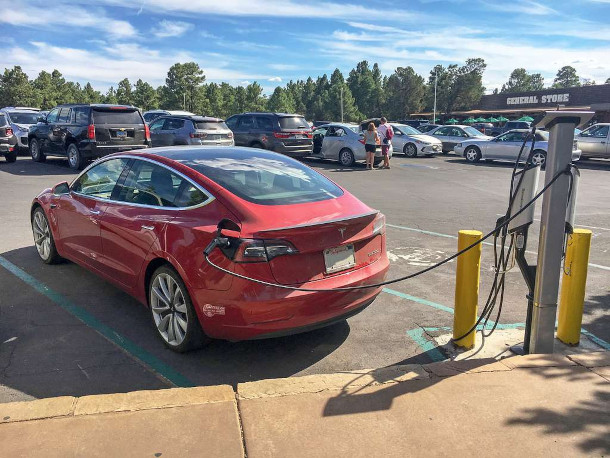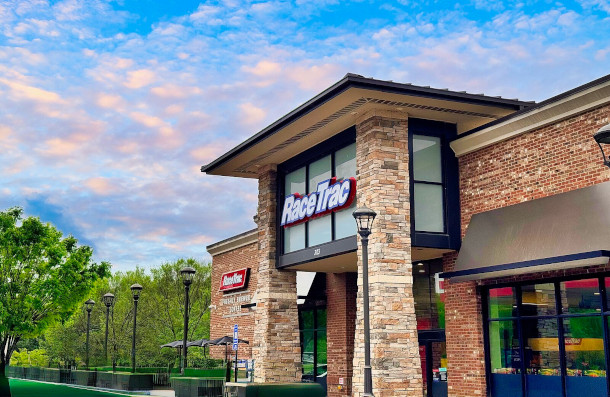EV Chargers Good for Business
Air Date: Week of November 1, 2024

Even as EVs' popularity grows, functioning charging ports are still difficult to find in some parts of the country. (Photo: Michael Quinn, NPS Photo, Picryl.com, public domain)
Research shows that public EV charging stations bring more customers and income to nearby businesses. Tik Root, senior staff writer at Grist, joins Host Jenni Doering to explain these benefits and how businesses can take advantage of them when installing EV charging.
Transcript
DOERING: On a road trip in an EV, you can’t just fill up anywhere. The US is still building out a reliable public charging network, and according to Pew Research, with two and half million electric vehicles on the road in the US there are only 61,000 publicly available places to plug in. To jumpstart the needed buildout, in late August the Biden administration announced a fresh round of grants to the tune of $521 million, funded in part by the 2021 Bipartisan Infrastructure Law. And recent research suggests that these charging stations will not only power the next generation of cars, but also boost nearby businesses. That might explain why companies like Walmart, Starbucks and Subway are adding EV chargers in their parking lots. Tik Root is a senior staff writer at Grist who reported on this research and joins us now. Hi Tik and welcome to Living on Earth!
ROOT: Hi, thanks for having me.
DOERING: So, as you wrote in your article, research suggests that having EV chargers nearby may give a boost to businesses. What were the findings of that research?
ROOT: So, the one study found there was roughly a $1,500 a year annual increase, and another found there was a roughly 4% increase in visitors. And one of those studies found that the rough distance was around 500 feet, that those chargers need to be within the business to have that effect.
DOERING: Right? Because the idea is, you plug your vehicle in. You are on foot at that point, wandering around getting a bite to eat, but you got to be back and unplug when you're done charging.
ROOT: Yeah, I think that's the idea. The researchers were telling me that they saw the most benefit for businesses whose services overlap with the charge time, anywhere from 20 minutes to an hour or so, which makes sense to me.
DOERING: And what types of businesses are installing EV chargers?
ROOT: So, I think you see them everywhere. I mean, at least anecdotally, from me driving around, I see them at everything from shopping malls to movie theaters to my local co-op, I think has a few EV chargers. But I think one of the places where I've heard that it makes the most sense, is convenience store type locations, they tend to also have disproportionately a lot of EV chargers.
DOERING: And why is that, do you think?
ROOT: I think they're usually located along transportation corridors, interstates, areas with high volume, so I think it's places where people will be needing to charge is, I guess, the idea.
DOERING: Right, because oftentimes people who use an EV would be able to charge at home, and then when they're on a road trip they would need to be able to stop and charge.
ROOT: Yeah, exactly. And my dad's an EV driver, and I've heard him stop at everywhere from a national park to a Subway sandwich shop.
DOERING: And you spoke with one of these stakeholders who's actually working on getting some of these chargers in, someone who works at this line of convenience stores called RaceTrac in the South. What were they grappling with as they considered whether to add these chargers?

RaceTrac, a southern convenance store chain installed EV chargers at some of its locations, boosting business. (Photo: Harrison Keely, Wikimedia Commons, CC BY 4.0)
ROOT: I think they had a few different factors. One big one was how to make money on actually selling electrons and making sure they could make that a profitable business. And a big part of that is that they have a complex input from the utility company in the way that they're charged. They're charged both connection fees, they're charged for the amount of energy they use, and they're charged for peak demand when they use it. And so, there's a whole bunch of factors that they have to weigh when deciding how much to charge a customer to charge as well. It's something they've grappled with. And others in the industry have told me that people have played with everything from time of day pricing to dynamic pricing, like Uber, to static pricing. And so, there's a lot of development in that field about how to charge customers for charging, so there's been some changes on that front. And then they are also looking at incentives from not only utilities but also the federal government that could help them install these chargers, which can be expensive. Level two chargers can run in the 10s of thousands of dollars to install and level three chargers can go into the hundreds of thousands, depending on the project. And you're seeing the federal government step in, the Biden administration has put billions of dollars towards rapidly expanding the EV network by 2030. And they've started to release grants to places Racetrack, for example, that I think it's nearly $700,000 to put in a few of these chargers. And so, this upfront money from the government, I think, is going to spur a lot of installations of new charges.
DOERING: And what are those different types of chargers, level two versus three?
ROOT: Yeah. So, level one chargers, just to start, they are the basic ones that you can plug into any outlet, and basically are slow trickle. They take a very long time to charge. We have a plug-in hybrid electric, and the level one charger takes about 12 hours to charge our car overnight. Well, we have a level two at our house. And so, the level two is basically a 220 outlet at your house, the same thing a dryer would run off of. And that takes about four hours on my car. And then my car is not compatible with level three charging. But level three is the fastest kind of charging, and those are the ones that can go from, say, 20 to 80% charged in a matter of half an hour or so depending on the car.

The Biden administration has set aside billions of dollars to build America’s EV charging infrastructure. Some of their grants are enabling local businesses to install chargers and reap the financial benefits. (Photo: Adam Schultz, Official White House Photo, public domain)
DOERING: So, what's going on at a business that's deciding which kind of charger to put in near their business? So, for example, when you talked with this person from RaceTrac, this line of convenience stores, how did they decide what ultimately was the kind of charger they were going to put in?
ROOT: I think most places that are trying to keep you there for 20 minutes, 30 minutes or so, would have to install a level three charger. A level two charger just wouldn't do much good for somebody who's on a road trip. You'd have to really be there for a few hours or so. I think predominantly convenience stores, etc., are putting in level three chargers. And then I think some places, like my local ski area, for example, has level two chargers because it's somewhere that you might be for 2, 3, 4, 5, 6, hours at a time. And I've seen level two chargers at malls. I think it's very much a use case situation.
DOERING: Having these chargers can be attractive to people who are on the road. They may be more likely, according to this research, to go into a nearby business. So, what are businesses doing to try and sweeten the deal for consumers?
ROOT: I think you're seeing a lot of businesses install the chargers. That's probably the first and most important thing they can do, is actually have one. And then I've seen everything from free charging for a certain amount of time to discounted charging. My ski area offers free charging when I'm skiing. There's a brewery in town that offers free charging. So, I think it's something that companies are grappling a lot with. I think you'll see that continue to evolve over time as more and more data becomes available. Internal combustion cars have been around for 100 plus years, and we're still in sort of the infancy of electric vehicles, so I think companies are still figuring out exactly what their approach will be, but it's interesting to watch them go about it.

Tik Root is a senior staff writer at Grist. He recently wrote an article about how nearby EV chargers boost business’ profits. (Photo: Mark Thiessen, National Geographic)
DOERING: So, what are the long-term implications of this research, and how might it shape the way EV chargers get built out across the country?
ROOT: One thing is it sort of dispels any notion that a business has to make some sort of tradeoff between being EV friendly and making money. Clearly, there are ways to do both of those things, which I think was apparent to some, but maybe not all businesses involved. Even for companies or businesses that may not have any interest in the other benefits of electric vehicles, they can at least know that they can potentially attract customers and at least sell the electricity in the way that it's profitable. That, in itself, takes some of the economics arguments against doing this off the table. It shows that we could potentially be poised for a big jump in EV charging stations in the future here. But of course, it's chicken or the egg, and you've seen EV sales start to slow. Perhaps you'll see some calibration as EV sales change, but it seems like the money, federally, at least, to install these charging stations, is there.
DOERING: Tik Root is a senior staff writer at Grist. Thank you so much, Tik.
ROOT: Thanks for having me.
Links
Learn about how you can receive a tax credit if you purchase an EV
Living on Earth wants to hear from you!
Living on Earth
62 Calef Highway, Suite 212
Lee, NH 03861
Telephone: 617-287-4121
E-mail: comments@loe.org
Newsletter [Click here]
Donate to Living on Earth!
Living on Earth is an independent media program and relies entirely on contributions from listeners and institutions supporting public service. Please donate now to preserve an independent environmental voice.
NewsletterLiving on Earth offers a weekly delivery of the show's rundown to your mailbox. Sign up for our newsletter today!
 Sailors For The Sea: Be the change you want to sea.
Sailors For The Sea: Be the change you want to sea.
 The Grantham Foundation for the Protection of the Environment: Committed to protecting and improving the health of the global environment.
The Grantham Foundation for the Protection of the Environment: Committed to protecting and improving the health of the global environment.
 Contribute to Living on Earth and receive, as our gift to you, an archival print of one of Mark Seth Lender's extraordinary wildlife photographs. Follow the link to see Mark's current collection of photographs.
Contribute to Living on Earth and receive, as our gift to you, an archival print of one of Mark Seth Lender's extraordinary wildlife photographs. Follow the link to see Mark's current collection of photographs.
 Buy a signed copy of Mark Seth Lender's book Smeagull the Seagull & support Living on Earth
Buy a signed copy of Mark Seth Lender's book Smeagull the Seagull & support Living on Earth

